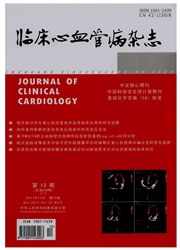

 中文摘要:
中文摘要:
目的:研究急性冠状动脉综合征(ACS)患者血清淀粉样蛋白A(SAA)水平的变化,探讨其作为易损斑块的检测指标的可能性。方法:设ACS组29例,慢性稳定型心绞痛(SAP)组28例,对照组31例。酶联免疫吸附测定法(ELIsA)测定高敏C反应蛋白(hsCRP)、白细胞介素-6(IL-6)、肿瘤坏死因子α(TNF—α)及SAA的表达比较。结果:ACS组血清hs—CRP、IL-6、TNF-α及SAA水平明显高于SAP组及对照组(P〈0.01);SAP组4种炎症标记物与对照组比较差异无统计学意义(P〉0.05)。结论:ACS患者SAA水平显著增高,对ACS的预测可能有重要的价值。
 英文摘要:
英文摘要:
Objective:To explore the effect of serum amyloid A (SAA) protein on patients with acute coronary syndrome (ACS). Method: There were three groups including ACS group (n = 29 ), chronic stable angina pectoris (SAP) group ( n = 28) and control group (n= 31 ). High sensitivity C-reactive protein ( hs-CRP), interleukin-6 (IL-6), tumor necrosis factor-alpha (TNF-α) and SAA protein were measured with enzymeqinked immunosorbent assay. Resalt:Hs-CRP, IL 6, TNF-α and SAA in patients with ACS were significantly higher than those in SAP and control group (P〈0.01). These 4 kinds of inflammatory markers had no obvious differences between SAP and control group (P〉0.05). Conclusion: SAA increases in patients with ACS and may be a valuable marker for predicting the severity of ACS.
 同期刊论文项目
同期刊论文项目
 同项目期刊论文
同项目期刊论文
 期刊信息
期刊信息
